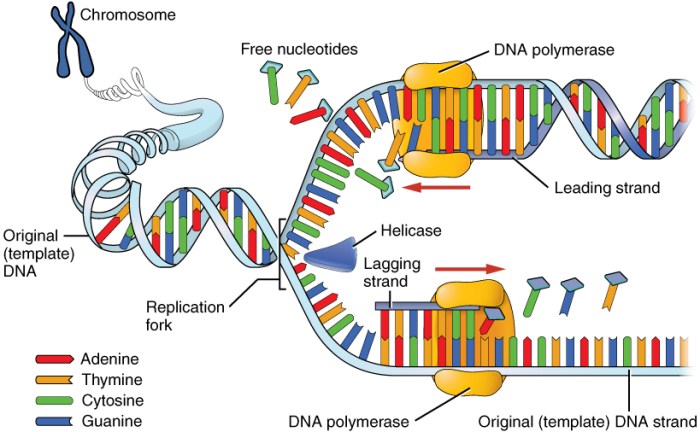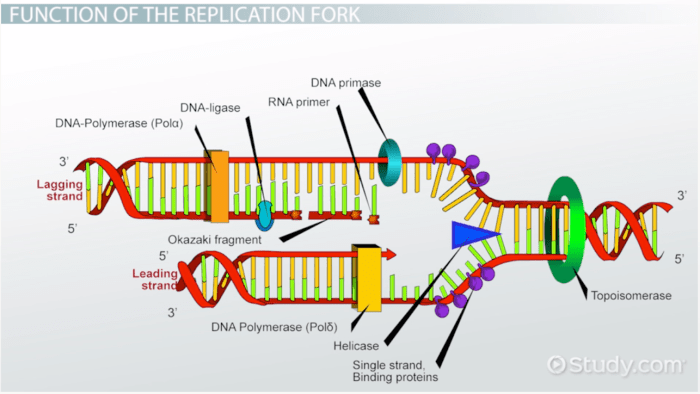Label the parts of the dna replication fork. – Label the parts of the DNA replication fork: the process by which genetic material is duplicated. This complex molecular machinery ensures the faithful transmission of genetic information during cell division, a fundamental process for all life forms. By delving into the components and steps involved in DNA replication, we gain insights into the intricate mechanisms that underpin the continuity of life.
The DNA replication fork, a Y-shaped structure, serves as the central hub for DNA replication. Here, a team of molecular players, including helicase, DNA polymerase, RNA primer, leading and lagging strands, work in concert to unwind, separate, and synthesize new DNA strands, ensuring the accurate duplication of genetic material.
Introduction: Label The Parts Of The Dna Replication Fork.

DNA replication is the process by which a cell makes a copy of its DNA. It is essential for cell division and growth, and for the transmission of genetic information from one generation to the next.
The basic structure of a DNA molecule is a double helix, consisting of two strands of nucleotides that are twisted around each other. Each nucleotide consists of a sugar molecule, a phosphate molecule, and a nitrogenous base. The four nitrogenous bases are adenine (A), thymine (T), guanine (G), and cytosine (C).
A always pairs with T, and G always pairs with C.
The DNA Replication Fork
The DNA replication fork is the Y-shaped region where DNA replication occurs. It consists of the following components:
- Helicase: Helicase is an enzyme that unwinds the DNA double helix, breaking the hydrogen bonds between the base pairs.
- DNA polymerase: DNA polymerase is an enzyme that synthesizes new DNA strands. It adds nucleotides to the growing strand in the 5′ to 3′ direction, using the existing strand as a template.
- RNA primer: RNA primer is a short piece of RNA that is synthesized by primase, an enzyme that initiates DNA replication. The RNA primer provides a free 3′ hydroxyl group for DNA polymerase to add nucleotides to.
- Leading and lagging strands: The leading strand is the strand that is synthesized continuously in the 5′ to 3′ direction. The lagging strand is the strand that is synthesized discontinuously in the 5′ to 3′ direction, in short fragments called Okazaki fragments.
Steps of DNA Replication
The overall process of DNA replication can be divided into the following steps:
- Strand separation: Helicase unwinds the DNA double helix, breaking the hydrogen bonds between the base pairs.
- Primer synthesis: Primase synthesizes a short piece of RNA primer on each strand of DNA.
- Nucleotide addition: DNA polymerase adds nucleotides to the growing strand in the 5′ to 3′ direction, using the existing strand as a template.
- Termination: DNA polymerase reaches the end of the template strand and stops synthesizing the new strand.
Regulation of DNA Replication

The initiation and progression of DNA replication is regulated by a number of factors, including:
- Origin recognition: DNA replication begins at specific sites in the DNA molecule called origins of replication. These sites are recognized by proteins called origin recognition complexes.
- Checkpoint control: Checkpoint control mechanisms ensure that DNA replication is accurate and complete. These mechanisms include the DNA damage checkpoint, which halts DNA replication if DNA damage is detected, and the replication checkpoint, which prevents DNA replication from proceeding if the previous round of replication was not completed.
- Telomere maintenance: Telomeres are specialized DNA sequences at the ends of chromosomes. They prevent the ends of chromosomes from fusing together and protect them from degradation. Telomerase is an enzyme that synthesizes telomeres, ensuring that they are maintained during DNA replication.
Applications of DNA Replication

DNA replication has a wide range of applications in fields such as:
- Biotechnology: DNA replication is used to produce recombinant DNA, which is DNA that has been modified by the insertion of foreign DNA. Recombinant DNA is used in a variety of applications, including the production of genetically modified organisms (GMOs) and the development of new drugs and therapies.
- Medicine: DNA replication is used in a variety of medical applications, including the diagnosis and treatment of genetic diseases. For example, DNA replication is used to identify mutations in genes that are associated with genetic diseases, and to develop gene therapies that can correct these mutations.
- Forensic science: DNA replication is used in forensic science to identify individuals from their DNA. For example, DNA replication is used to match DNA samples from crime scenes to DNA samples from suspects.
Frequently Asked Questions
What is the significance of the DNA replication fork?
The DNA replication fork is crucial for cell division, ensuring the faithful transmission of genetic material to daughter cells.
What are the key components of the DNA replication fork?
Helicase, DNA polymerase, RNA primer, leading and lagging strands are the primary components involved in the DNA replication process.
How is the DNA replication process regulated?
DNA replication is tightly regulated through mechanisms like origin recognition, checkpoint control, and telomere maintenance, ensuring the accuracy and timely completion of the process.